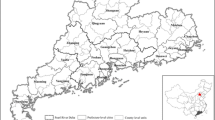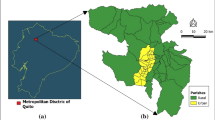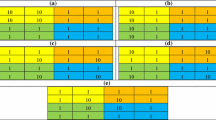Abstract
Regional inequality is a core issue in geography, and it can be measured by several approaches and indexes. However, the global inequality measures can not reflect regional characteristics in terms of spatiality and non-mobility, as well as correctly explore regional inequality in particular directions. Although conventional between-group inequality indexes can measure the inequality in particular directions, they can not reflect the reversals of regional patterns and changes of within-group patterns. Therefore, we set forth a new approach to measure regional inequality in particular directions, which is applicable to geographic field. Based on grouping, we established a new index to measure regional inequality in particular directions named Particular Direction Inequality index (PDI index), which is comprised of between-group inequality of all data and between-group average gap. It can reflect regional spatiality and non-mobility, judge the main direction of regional inequality, and capture the changes and reversals of regional patterns. We used the PDI index to measure the changes of regional inequality from 1952 to 2009 in China. The results show that: 1) the main direction of China’s regional inequality was between coastal areas and inland areas; the increasing extent of inequality between coastal areas and inland areas was higher than the global inequality; 2) the PDI index can measure the between-region average gap, and is more sensitive to evolution of within-region patterns; 3) the inequality between the northern China and the southern China has been decreasing from 1952 to 2009 and was reversed in 1994 and 1995.
Similar content being viewed by others
References
Akita T, 2003. Decomposing regional income inequality in China and Indonesia using two-stage nested Theil decomposition method. The Annals of Regional Science, 37(1): 55–77. doi: 10.1007/s001680200107
Akita T, Miyata S, 2010. The bi-dimensional decomposition of regional inequality based on the weighted coefficient of variation. Letters in Spatial and Resource Sciences, 3(3): 91–100. doi: 10.1007/s12076-010-0040-x
Atkinson A B, 1970. On the measurement of inequality. Journal of Economic Theory, 2(3): 244–263. doi: 10.1016/0022-0531(70)90039-6
Bhattacharya N, Mahalanobis B, 1967. Regional disparities in household consumption in India. Journal of the American Statistical Association, 62(317): 143–161.
Chen J, Belton F, 1996. Regional income inequality and economic growth in China. Journal of Comparative Economics, 22(2): 141–164. doi: 10.1006/jcec.1996.0015
Cowell, Frank A, 1995. Measuring Inequality, Second Edition. London: Prentice Hall/Harvester Wheatsheaf.
Fan C C, 1995. Of belts and ladders: state policy and uneven regional development in post-Mao China. Annals of the Association of American Geographers, 85(3): 421–449. doi: 10.1111/j.1467-8306.1995.tb01807.x
Fan C C, Sun M, 2008. Regional inequality in China, 1978–2006. Eurasian Geography and Economics, 48(1): 1–20. doi: 10.2747/1539-7216.49.1.1
Fujita M, Hu D, 2001. Regional disparity in China 1985-1994: The effects of globalization and economic liberalization. Annals of Regional Science, 35(1): 3–37. doi: 10.1007/s001680000020
Gini C, 1912. Variabilità e Mutabilità. Bologna: Tipografia Di Paolo Cuppini.
Hong Xingjian, 2008. A new subgroup decomposition of the Gini coefficient. China Economic Quarterly, 8(1): 307–324. (in Chinese)
Huang J, Kuo C, Kao A, 2003. The inequality of regional economic development in China between 1991 and 2001. Journal of Chinese Economic and Business Studies, 1(3): 273–285. doi: 10.1080/476828032000108553
Jian T, Sachs J D, Warner A M, 1996. Trends in regional inequality in China. China Economic Review, 7(1): 1–21. doi: 10.1016/S1043-951X (96)90017-6
Jin Cheng, Lu Yuqi, 2009. Evolvement of spatial pattern of economy in Jiangsu province at county level. Acta Geographica Sinica, 64(6): 713–724. (in Chinese)
Jonathan M, Terry S, 2002. Rethinking inequality decomposition with evidence from rural China. The Economic Journal, 112(476): 93–106. doi: 10.1111/1468-0297.0j674
Josef N, 2007. On the measurement of regional inequality: Does spatial dimension of income inequality matter? The Annals of Regional Science, 41(3): 563–580. doi: 10.1007/s00168-007-0113-y
Kanbur R, Zhang X, 1999. Which regional inequality? The evolution of rural-urban and inland-coastal inequality in China, 1983–1995. Journal of Comparative Economics, 27(4): 686–701. doi: 10.1006/jcec.1999.1612
Kanbur R, Zhang X, 2005. Fifty years of regional inequality in China: A journey through central planning, reform, and openness. Review of Development Economics, 9(1): 87–106. doi: 10.1111/j.1467-9361.2005.00265.x
Lee J, 2000. Changes in the source of China’s regional inequality. China Economic Review, 11(3), 232–245. doi: 10.1016/S1043-951X(00)00019-5
Li Erling, Qin Chenglin, 2002. A positive study of regional economic diversities between the South and the North in China. Geography and Territorial Research, 18(4): 76–78. (in Chinese)
Li Xiuwei, Xiu Chunliang, 2008. New pattern of regional economic polarization in the three Northeast provinces of China. Scientia Geographica Sinica, 28(6): 722–728. (in Chinese)
Liu Hui, 2006. Regional inequality measurement: methods and evaluations. Geographical Research, 25(4): 710–718. (in Chinese)
Liu Zhiwei, 2003. Measurement of income distribution inequities methods. Statistics & Information Tribune, 18(5): 28–32. (in Chinese)
Long Genying, 1999. China’s changing regional disparities during the reform period. Economic Geography, 75(1): 59–70. doi: 10.1111/j.1944-8287.1999.tb00074.x
Lu M, Wang E, 2002, Forging ahead and falling behind: Changing regional inequalities in post-reform China. Growth and Change, 33(1): 42–71. doi: 10.1111/0017-4815.00179
Martin H, Christoph W, 2008. Patterns of regional inequality in the enlarged Europe. European Sociological Review, 24(1): 19–36. doi: 10.1093/esr/jcm031
Max L, Wang E, 2002. Forging ahead and falling behind: changing regional inequalities in post-reform China. Growth and Change, 33(1): 42–71. doi: 10.1111/0017-4815.00179
National Bureau of Statistics of China, 2010a. China Compendium of Statistics 1949–2008. Beijing: China Statistics Press. (in Chinese)
National Bureau of Statistics of China, 2010b. China Statistical Yearbook 2009. Beijing: China Statistics Press. (in Chinese)
National Bureau of Statistics of China, 2011. China Statistical Yearbook 2010. Beijing: China Statistics Press. (in Chinese)
Qin Chenglin, Zhang Hua, Zhang Jihui, 2011. New trend and causes of regional development disparity in China: Measurement based on population weighted coefficient and spatial-industrial decomposition. China Industrial Economic, 283(10): 37–45. (in Chinese)
Rui H, Zheng W, 2010. Fundamental causes of inland-coastal income inequality in post-reform China. The Annals of Regional Science, 45(1): 181–206. doi: 10.1007/s00168-008-0281-4
Shannon C, Wiener W, 1949. The Mathematical Theory of Communications. Urbana: The University of Illinois Press.
Shorrocks A, 1980. The class of additively decomposable inequality measures. Econometrica, 48(3): 613–625. doi:10.2307/1913126
Shorrocks A, 1984. Inequality decomposition by population subgroup. Econometrica, 52(6): 1369–1385. doi: 10.2307/1913511
Theil H, 1967. Economics and Theory. Amsterdam: North Holland Publishing Company.
Tsui K, 1993. Decomposition of China’s regional inequalities. Journal of Comparative Economics, 17(3): 600–627. doi: 10.1006/jcec.1993.1045
Tsui K, 1996. Economic reform and interprovincial inequalities in China. Journal of Development Economics, 50(2): 353–368. doi: 10.1016/S0304-3878(96)00406-3
Wan G, 2001. Changes in regional inequality in rural China: Decomposing the Gini index by income sources. The Australian Journal of Agricultural and Resource Economics, 45(3): 361–381. doi: 10.1111/1467-8489.00148
Wan G, Ming L, Zhao C, 2007. Globalization and regional income inequality: empirical evidence from within China. Review of Income and Wealth, 53(1): 35–59. doi: 10.1111/j.1475-4991.2007.00217.x
Wang C, Barreto L, Zou J, 2004. China’s GDP: Examining provincial disparities (1952–1998). International Journal of Asian Management, 3(1): 77–101. doi: 10.1007/s10276-004-0021-1
Wang Yang, Xiu Chunliang, 2010. The spatial-temporal evolution of regional economic pattern at prefecture level in China: 1990–2008. Progress in Geography, 30(8): 1037–1046. (in Chinese)
Wang Yunfei, 2007. Tendency of China’s regional income gap: Analysis based on the decomposition of Gini index. Journal of Shanxi Finance and Economics University, 29(8): 28–32. (in Chinese)
Wei K, Yao S, Liu A, 2009. Foreign direct investment and regional inequality in China. Review of Development Economics, 13(4): 778–791. doi: 10.1111/j.1467-9361.2009.00516.x
Wei Y D, 2002. Multiscale and multimechanisms of regional inequality in China: Implications for regional policy. Journal of Contemporary China, 11(30): 109–124. doi: 10.1080/10670560120091165
Williamson J G, 1965. Regional inequality and the process of national development: A description of the patterns. Economic Development and Cultural Change, 13(4): 3–45.
Wu Dianting, 2001. A study on North-South differences in economic growth. Geographical Research, 20(2): 238–246. (in Chinese)
Wu Shidai, Wang Qiang, 2008. Regional economic disparities and coordination of economic development in coastal areas of southeastern China, 1995–2005. Acta Geographica Sinica, 63(2): 123–134. (in Chinese)
Xu Jianhua, Lu Feng, Su Fanglin et al., 2005. Spatial and temporal scale analysis on the regional economic disparities in China. Geographical Research, 24(1): 57–68. (in Chinese)
Xu Zhaoyuan, Li Shantong, 2006. Analysis on the trend of regional income disparity in China. Economic Research Journal, (7): 106–116. (in Chinese)
Yao Shujie, Liu Jirui, 1996. Decomposition of Gini coefficients by class: A new approach. Applied Economics Letters, 3(2): 115–119. doi: 10.1080/135048596356825
Yao S, 1999. On the Decomposition of Gini coefficients by population class and income source: A spreadsheet approach and application. Applied Economics, 31(10): 1249–1264. doi: 10.1080/000368499323463
Zhang X B, Kanbur R, 2001. What difference do polarization measures make? An application to China. Journal of Development Studies, 37(3): 85–98. doi: 10.1080/00220380412331321981
Zhao Jianan, 1998. A study on the complementarily of regional economic development in South china and North China. Geographical Research, 17(4): 375–382. (in Chinese)
Zhou Qingxing, Gao Qian, Ding Congming et al., 2005. Analysis of club convergence phenomenon in China. Journal of Hebei University of Economics and Trade, 26(5): 36–39. (in Chinese)
Author information
Authors and Affiliations
Corresponding author
Additional information
Foundation item: Under the auspices of National Natural Science Foundation of China (No. 40971101), Main Direction Program of Knowledge Innovation of Chinese Academy of Sciences (No. KZC X2-YW-321-05)
Rights and permissions
About this article
Cite this article
Wang, Y., Fang, C., Xiu, C. et al. A new approach to measurement of regional inequality in particular directions. Chin. Geogr. Sci. 22, 705–717 (2012). https://doi.org/10.1007/s11769-012-0556-7
Received:
Accepted:
Published:
Issue Date:
DOI: https://doi.org/10.1007/s11769-012-0556-7




